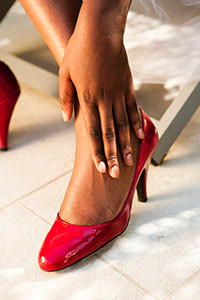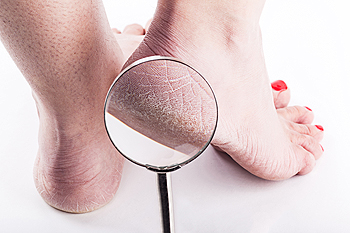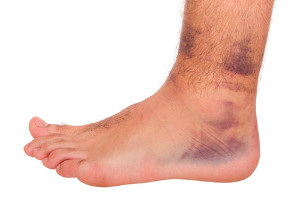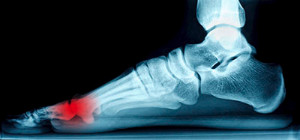April 2019
What Is Cuboid Syndrome?
 The bones that are found on the outside of the foot are referred to as the tarsal bones. The cuboid bone has six sides, and is located within these group of bones. The function of this bone is to keep the foot stabilized in addition to evenly distributing the body’s weight. If an injury should occur that affects the cuboid bone, a condition that is known as cuboid syndrome may develop. This can happen as a result of an injury that includes sprained ankles, or possibly from performing repetitive motions that running and dancing are comprised of. The symptoms that are associated with this condition often include pain and discomfort that is felt on the outside of the foot, and it may be difficult to walk. If you have experienced an injury, and notice pain on one side of your foot, it is advised to counsel with a podiatrist who can recommend correct treatment options.
The bones that are found on the outside of the foot are referred to as the tarsal bones. The cuboid bone has six sides, and is located within these group of bones. The function of this bone is to keep the foot stabilized in addition to evenly distributing the body’s weight. If an injury should occur that affects the cuboid bone, a condition that is known as cuboid syndrome may develop. This can happen as a result of an injury that includes sprained ankles, or possibly from performing repetitive motions that running and dancing are comprised of. The symptoms that are associated with this condition often include pain and discomfort that is felt on the outside of the foot, and it may be difficult to walk. If you have experienced an injury, and notice pain on one side of your foot, it is advised to counsel with a podiatrist who can recommend correct treatment options.
Cuboid syndrome, also known as cuboid subluxation, occurs when the joints and ligaments near the cuboid bone in the foot become torn. If you have cuboid syndrome, consult with Dr. Scott Shrem from Garden State Foot & Ankle Center. Our doctor will assess your condition and provide you with quality foot and ankle treatment.
Cuboid syndrome is a common cause of lateral foot pain, which is pain on the outside of the foot. The condition may happen suddenly due to an ankle sprain, or it may develop slowly overtime from repetitive tension through the bone and surrounding structures.
Causes
The most common causes of cuboid syndrome include:
- Injury – The most common cause of this ailment is an ankle sprain.
- Repetitive Strain – Tension placed through the peroneus longus muscle from repetitive activities such as jumping and running may cause excessive traction on the bone causing it to sublux.
- Altered Foot Biomechanics – Most people suffering from cuboid subluxation have flat feet.
Symptoms
A common symptom of cuboid syndrome is pain along the outside of the foot which can be felt in the ankle and toes. This pain may create walking difficulties and may cause those with the condition to walk with a limp.
Diagnosis
Diagnosis of cuboid syndrome is often difficult, and it is often misdiagnosed. X-rays, MRIs and CT scans often fail to properly show the cuboid subluxation. Although there isn’t a specific test used to diagnose cuboid syndrome, your podiatrist will usually check if pain is felt while pressing firmly on the cuboid bone of your foot.
Treatment
Just as the range of causes varies widely, so do treatments. Some more common treatments are ice therapy, rest, exercise, taping, and orthotics.
If you have any questions, please feel free to contact our office located in Hazlet, NJ . We offer the newest diagnostic and treatment technologies for all your foot care needs.
Cuboid Syndrome
Cuboid syndrome mostly affects athletes, although it can affect non-athletes too. It is also known as cuboid subluxation or cuboid fault syndrome. This condition occurs when joints and ligaments near the cuboid bone of the foot are damaged, or when the cuboid bone itself is dislodged from its natural position. It is usually marked by pain on the outer side of the foot, which may be persistent or may come and go. Cuboid syndrome can be difficult to diagnose unless it becomes severe and more noticeable. Your doctor will likely ask questions about when the pain began and how long it has been present, and will put pressure on the cuboid bone to determine if that area is the origin of the pain.
Causes of Cuboid Syndrome
- Any repetitive stresses placed on the foot due to athletic activities are a common cause of cuboid syndrome.
- Although it develops over time, it is possible that this syndrome can occur all of sudden due to a single event or injury.
- Over-pronation can exacerbate the condition if not corrected.
Disagreements Amongst Podiatrists Regarding Cuboid Syndrome
- Some refer to it as the dislocation of the calcaneal-cuboid joint only.
- Other podiatrists see it as an injury of the ligaments located nearby, which also involves the cuboid bone.
It is very important that when you experience any kind of pain on the side of your foot, you should seek medical care right away. If a subluxed cuboid is caught early, your feet may respond well to the treatment, and you can get back into sports or other activities again as soon as the pain subsides.
Foot and Ankle Surgery
When conservative, noninvasive methods prove ineffective, surgery may be selected as the next course of action for the treatment of your foot or ankle condition. A wide number of foot and ankle surgical procedures exist, and it is up to your podiatrist to determine which intervention will be most appropriate and helpful for your case. Some surgical procedures include bunion surgery, fusion, hammertoe surgery, heel spur surgery, metatarsal surgery, nail surgery, neuroma surgery, reconstructive surgery, skin surgery, and tendon surgery. Typically, surgery is turned to as a definitive way to alleviate excessive pain or discomfort and to return your foot to full mobility.
Regardless of the location on the body, all surgical procedures require preoperative testing and examination to ensure the surgery’s success and preferred outcome. A review of your medical history and medical conditions will take place, as will an evaluation of any current diseases, illnesses, allergies, and medications. Tests such as blood studies, urinalyses, EKG, X-rays, and blood flow studies may be ordered. Because the procedure involves the foot and/or ankle, the structures of your feet while walking may also be observed by your podiatrist.
Care post-surgery will depend on the type of surgical procedure performed. Typically, all postoperative care involves rest, ice, compression, and elevation. To improve and ensure a safe recovery, your foot and ankle surgeon may also employ the use of bandages, splints, surgical shoes, casts, crutches, or canes. He will also determine if and when you can bear weight. A timely and thorough recovery is a priority for both you and your podiatrist, and carefully following postoperative instructions can help achieve this.
Aftercare for Hammertoe Surgery
 Many patients elect to have surgery done to permanently correct hammertoe. After surgery is performed, it is recommended to wear certain shoes that are designed to keep the toe in the correct position for several weeks. These types of shoes also provide adequate protection for the affected toe. Research has indicated that it is beneficial to walk for limited amounts of time throughout the day. This is helpful in increasing blood flow in the body, which aids in faster healing. Additionally, swelling may be diminished when the foot is elevated. If you have hammertoe, and are considering treatment options that include surgery, it is strongly suggested that you speak with a podiatrist who can properly guide you.
Many patients elect to have surgery done to permanently correct hammertoe. After surgery is performed, it is recommended to wear certain shoes that are designed to keep the toe in the correct position for several weeks. These types of shoes also provide adequate protection for the affected toe. Research has indicated that it is beneficial to walk for limited amounts of time throughout the day. This is helpful in increasing blood flow in the body, which aids in faster healing. Additionally, swelling may be diminished when the foot is elevated. If you have hammertoe, and are considering treatment options that include surgery, it is strongly suggested that you speak with a podiatrist who can properly guide you.
Foot surgery is sometimes necessary to treat a foot ailment. To learn more, contact Dr. Scott Shrem of Garden State Foot & Ankle Center. Our doctor will assist you with all of your foot and ankle needs.
When Is Surgery Necessary?
Foot and ankle surgery is generally reserved for cases in which less invasive, conservative procedures have failed to alleviate the problem. Some of the cases in which surgery may be necessary include:
- Removing foot deformities like bunions and bone spurs
- Severe arthritis that has caused bone issues
- Cosmetic reconstruction
What Types of Surgery Are There?
The type of surgery you receive will depend on the nature of the problem you have. Some of the possible surgeries include:
- Bunionectomy for painful bunions
- Surgical fusion for realignment of bones
- Neuropathy decompression surgery to treat nerve damage
Benefits of Surgery
Although surgery is usually a last resort, it can provide more complete pain relief compared to non-surgical methods and may allow you to finally resume full activity.
Surgical techniques have also become increasingly sophisticated. Techniques like endoscopic surgery allow for smaller incisions and faster recovery times.
If you have any questions please feel free to contact our office located in Hazlet, NJ . We offer the newest diagnostic and treatment technologies for all your foot and ankle needs.
Causes of Cracked Heels
 Severely dry skin on the feet may lead to cracked heels. Bleeding, in addition to pain and discomfort can occur as a result of this ailment. Other symptoms may include hard, yellowed skin, and the skin may appear flaky as well. There are several reasons why cracked heels may develop. These can include standing for extended periods of time for the majority of the day, wearing shoes that have an open back, or having an existing medical conditions such as flat feet or a thyroid disorder. Mild relief may be found when the feet are washed and dried thoroughly, followed by utilizing a good moisturizer. If the pain becomes severe, it is suggested that you seek the counsel of a podiatrist who can properly treat this condition.
Severely dry skin on the feet may lead to cracked heels. Bleeding, in addition to pain and discomfort can occur as a result of this ailment. Other symptoms may include hard, yellowed skin, and the skin may appear flaky as well. There are several reasons why cracked heels may develop. These can include standing for extended periods of time for the majority of the day, wearing shoes that have an open back, or having an existing medical conditions such as flat feet or a thyroid disorder. Mild relief may be found when the feet are washed and dried thoroughly, followed by utilizing a good moisturizer. If the pain becomes severe, it is suggested that you seek the counsel of a podiatrist who can properly treat this condition.
If the skin on your feet starts to crack, you may want to see a podiatrist to find treatment. If you have any concerns, contact Dr. Scott Shrem from Garden State Foot & Ankle Center. Our doctor can provide the care you need to keep you pain-free and on your feet.
Cracked Heels
It is important to moisturize your cracked heels in order to prevent pain, bleeding, and infection. The reason cracked heels form is because the skin on the foot is too dry to support the immense pressure placed on them. When the foot expands, the dry skin on the foot begins to split.
Ways to Help Heal Them
- Invest in a good foot cream
- Try Using Petroleum Jelly
- Ease up on Soaps
- Drink Plenty of Water
Ways to Prevent Cracked Heels
- Moisturize After Showering
- Skip a Shower
- Keep Shower Water Lukewarm
- Don’t Scrub Your Feet
If you are unsure how to proceed in treating cracked heels, seek guidance from a podiatrist. Your doctor will help you with any questions or information you may need.
If you have any questions, please feel free to contact our office located in Hazlet, NJ . We offer the newest diagnostic and treatment technologies for all your foot care needs.
Solutions for Cracked Heels
Cracked heels may make you want to think twice about showing off your feet in warmer weather. However, cracked heels may be harmful to more than just the appearance of your feet. If deep fissures and cracks develop in your heels, they may make walking and standing painful for you. Additionally, these openings make way for germs to enter through your skin and cause infection.
There are several different causes of cracked heels. One of the most common reasons for this ailment is dry skin. This problem may make your keeps feel rough tight and itchy. Dry skin may be caused by cold air, extremely hot water, harsh soaps, and aging. Skin disorders such as eczema and psoriasis may eventually lead to dry skin. In some cases, complications may arise from cracked heels. Some of these complications are a loss of feeling in the heel, cellulitis, or a diabetic foot ulcer.
There are ways you can try to prevent getting cracked heels. One of the best ways to do so is to avoid wearing flip flops and sandals because these shoes increase your risk of drying out your feet. You should also avoid wearing shoes with a tall skinny heel, because these shoes cause your heel to expand sideways. At night, you should slather on a thick moisturizing cream on your feet and then cover them in socks to keep your feet moisturized overnight. Drinking water to stay hydrated is also a good way to ensure that your skin doesn’t become dry.
If you suffer from a severe case of cracked feet, you should make an appointment with your podiatrist to see what treatment methods are best for you.
Different Types of Ankle Sprains
 Many teenagers may experience the pain and discomfort of an ankle sprain. This may be the result of torn ligaments in the ankle or the surrounding area, and may occur as sporting activities are pursued. Research has indicated there are three types of ankle sprains. A sprain is known to be mild when the ligaments are slightly stretched. If the ligaments are marginally torn, the sprain is considered to be moderate, and putting weight on the foot may be painful. If the ligament should completely tear, the sprain is severe. This is typically accompanied by swelling, and it may be impossible for the foot to bear any amount of weight. There are methods that can be implemented for keeping the ankles strong, which may help in preventing ankle sprains. These include performing gentle stretching exercises to help keep the ankles flexible and wearing shoes that have adequate ankle support. If you have sprained your ankle, it is strongly suggested that you speak to a podiatrist who can begin the correct treatment for you.
Many teenagers may experience the pain and discomfort of an ankle sprain. This may be the result of torn ligaments in the ankle or the surrounding area, and may occur as sporting activities are pursued. Research has indicated there are three types of ankle sprains. A sprain is known to be mild when the ligaments are slightly stretched. If the ligaments are marginally torn, the sprain is considered to be moderate, and putting weight on the foot may be painful. If the ligament should completely tear, the sprain is severe. This is typically accompanied by swelling, and it may be impossible for the foot to bear any amount of weight. There are methods that can be implemented for keeping the ankles strong, which may help in preventing ankle sprains. These include performing gentle stretching exercises to help keep the ankles flexible and wearing shoes that have adequate ankle support. If you have sprained your ankle, it is strongly suggested that you speak to a podiatrist who can begin the correct treatment for you.
Although ankle sprains are common, they aren’t always minor injuries. If you need your ankle injury looked at, contact Dr. Scott Shrem from Garden State Foot & Ankle Center. Our doctor can provide the care you need to keep you pain-free and on your feet.
How Does an Ankle Sprain Occur?
Ankle sprains are the result of a tear in the ligaments within the ankle. These injuries may happen when you make a rapid shifting movement while your foot is planted. A less common way to sprain your ankle is when your ankle rolls inward while your foot turns outward.
What Are the Symptoms?
- Pain at the sight of the tear
- Bruising/Swelling
- Ankle area is tender to touch
- In severe cases, may hear/feel something tear
- Skin discoloration
Preventing a Sprain
- Wearing appropriate shoes for the occasion
- Stretching before exercises and sports
- Knowing your limits
Treatment of a Sprain
In many cases, the RICE method (Rest, Ice, Compression, and Elevate) is used to treat ankle sprains. However, you should see a podiatrist to see which treatment option would work best with your injury. In severe cases, surgery may be required.
It is important to ask your doctor about rehab options after you receive treatment for your injury. Stretching, strength training, and balance exercises may help the ankle heal while also preventing further injury.
If you have any questions, please feel free to contact our office located in Hazlet, NJ . We offer the newest diagnostic and treatment technologies for all your foot care needs.
Ankle Sprains
Ankle sprains occur when ligaments that support the ankle stretch beyond their limits and tear. These types of injuries are very common and can occur in people of all ages. Sprains may range from mild to severe, depending on how much damage is done to the ligaments. If a sprain goes untreated, a more severe sprain may occur which can further damage the ankle. Repeated ankle sprains can lead to chronic ankle pain.
There are some risk factors that can increase your risk of suffering a sprained ankle. Those who participate in sports, walk on uneven surfaces, have a prior ankle injury, are in poor physical condition, or wear improper shoes are more likely to get a sprained ankle.
There are a few symptoms to look out for if you suspect you are suffering from a sprained ankle. Some common symptoms are swelling, bruising, tenderness, and instability of the ankle. In cases where the tearing of the ligaments is severe, there may be a “popping” sound when the strain occurs.
The RICE method is proven to be effective in treating ankle sprains. RICE stands for Rest, Ice, Compression, and Elevation. Rest is important for treatment, especially within the first 24 to 48 hours. You should also ice your sprained ankle for the first 48 hours for 20 minutes at a time. A small piece of cloth should be placed between the ice and the affected area. For the compression step, you should wear a brace that is snug, but not too tight that it cuts off circulation. When choosing a brace, be sure to choose one that is suitable for the type of ankle sprain you have. Lastly, you should elevate your foot above the heart as often as possible.
After you treat a sprain, you should go through rehabilitation to prevent the injury from occurring again. There are three phases to the rehab process. The first phase involves resting, protecting, and reducing the swelling of the injury. The second phase consists of restoring the ankle’s flexibility, range of motion, and strength. The third phase consists of slowly returning to activity and maintenance exercises.
If you suspect you have an ankle sprain, you shouldn’t hesitate to consult with your podiatrist. Your podiatrist will be able to give you a proper diagnosis and a suitable treatment option for your condition.
The Location of the Sesamoid Bones
 The sesamoid bones are located at the bottom of the big toe. The purpose of the sesamoid bones is to protect the tendons in that area of the foot, in addition to increasing mobility of the tendons. If these bones should become irritated and inflamed, a condition that is known as sesamoiditis may develop. Common causes of this ailment may include overuse of the tendons which may occur while participating in sporting activities, or from a sudden injury. There are typical symptoms that may be associated with sesamoiditis, and these may include pain that is felt in the toes while walking, and discomfort may be present when the big toe is pulled up. Wearing proper footwear may help to relieve pressure on the sesamoid bones, in addition to adding custom made orthotics to your shoes. If you feel you have this condition, it is advised that you schedule a consultation with a podiatrist so the correct treatment can begin.
The sesamoid bones are located at the bottom of the big toe. The purpose of the sesamoid bones is to protect the tendons in that area of the foot, in addition to increasing mobility of the tendons. If these bones should become irritated and inflamed, a condition that is known as sesamoiditis may develop. Common causes of this ailment may include overuse of the tendons which may occur while participating in sporting activities, or from a sudden injury. There are typical symptoms that may be associated with sesamoiditis, and these may include pain that is felt in the toes while walking, and discomfort may be present when the big toe is pulled up. Wearing proper footwear may help to relieve pressure on the sesamoid bones, in addition to adding custom made orthotics to your shoes. If you feel you have this condition, it is advised that you schedule a consultation with a podiatrist so the correct treatment can begin.
Sesamoiditis is an unpleasant foot condition characterized by pain in the balls of the feet. If you think you’re struggling with sesamoiditis, contact Dr. Scott Shrem of Garden State Foot & Ankle Center. Our doctor will treat your condition thoroughly and effectively.
Sesamoiditis
Sesamoiditis is a condition of the foot that affects the ball of the foot. It is more common in younger people than it is in older people. It can also occur with people who have begun a new exercise program, since their bodies are adjusting to the new physical regimen. Pain may also be caused by the inflammation of tendons surrounding the bones. It is important to seek treatment in its early stages because if you ignore the pain, this condition can lead to more serious problems such as severe irritation and bone fractures.
Causes of Sesamoiditis
- Sudden increase in activity
- Increase in physically strenuous movement without a proper warm up or build up
- Foot structure: those who have smaller, bonier feet or those with a high arch may be more susceptible
Treatment for sesamoiditis is non-invasive and simple. Doctors may recommend a strict rest period where the patient forgoes most physical activity. This will help give the patient time to heal their feet through limited activity. For serious cases, it is best to speak with your doctor to determine a treatment option that will help your specific needs.
If you have any questions please feel free to contact our office located in Hazlet, NJ . We offer the newest diagnostic and treatment technologies for all your foot and ankle needs.
Sesamoiditis
Sesamoiditis is a condition in which the sesamoid bones in the forefoot become inflamed from physical activity. Sesamoid bones are bones that are not connected to other bones but are located in tendons or muscle. Two of these sesamoid bones are very small and located on the underside of the foot near the big toe. Athletes such as runners, baseball and football players, and dancers are likely to experience sesamoiditis. Those with high arched feet, flat feet, or runners who run on the ball of their foot are also prone to suffer from sesamoiditis.
Symptoms include pain or throbbing on the ball of the foot near the big toe. The pain generally starts with a mild throbbing but gradually builds up to shooting pain. Bruising, swelling, and redness are possible, but in most cases, these symptoms are not present. However, moving the big toe can result in pain and difficulty.
To conduct a diagnosis, the podiatrist will examine the ball of the foot and big toe. They will look for any outliers and check the movement of the toe. X-rays will be taken to rule out any other conditions and ensure that it is sesamoiditis.
Treatment for sesamoiditis is generally mild and includes rest, anti-inflammatory and pain medication, and ice treatments to deal with the swelling and pain. Orthotics may be needed with people who have flat or high arched feet to relieve pressure off the bones. In some cases the toe will be taped and immobilized to allow healing. The podiatrist may also decide to use a steroid injection to help with swelling as well. If you have sesamoiditis, you shouldn’t engage in any intensive activity, as it may inflame the area and worsen your pain. If the sesamoid bone has fractured, surgery may be required to remove the sesamoid bone.
If you are suffering from sesamoiditis or are experiencing symptoms similar to sesamoiditis, you should stop all physical activity that puts strain on the area. Furthermore you should see a podiatrist for a diagnosis to see if you have sesamoiditis.
Blog Archives
- April 2025
- March 2025
- February 2025
- January 2025
- December 2024
- November 2024
- October 2024
- September 2024
- August 2024
- July 2024
- June 2024
- May 2024
- April 2024
- March 2024
- February 2024
- January 2024
- December 2023
- November 2023
- October 2023
- September 2023
- August 2023
- July 2023
- June 2023
- May 2023
- April 2023
- March 2023
- February 2023
- January 2023
- December 2022
- November 2022
- October 2022
- September 2022
- August 2022
- July 2022
- June 2022
- May 2022
- April 2022
- March 2022
- February 2022
- January 2022
- December 2021
- November 2021
- October 2021
- September 2021
- August 2021
- July 2021
- June 2021
- May 2021
- April 2021
- March 2021
- February 2021
- January 2021
- December 2020
- November 2020
- October 2020
- September 2020
- August 2020
- July 2020
- June 2020
- May 2020
- April 2020
- March 2020
- February 2020
- January 2020
- December 2019
- November 2019
- October 2019
- September 2019
- August 2019
- July 2019
- June 2019
- May 2019
- April 2019
- March 2019
- February 2019
- January 2019
- December 2018
- November 2018
- October 2018
- September 2018
- August 2018
- July 2018
- June 2018
- May 2018
- April 2018
- March 2018








